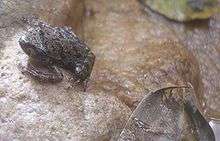Ghost frog
Heleophrynidae is a family of frogs, commonly known as ghost frogs. The family consists of two genera, Heleophryne and Hadromophryne, with seven species. Ghost frogs live in swift-moving mountain streams in South Africa. The common name of "ghost frogs" may have been coined because of their occurrence in Skeleton Gorge.[1]
| Ghost frogs | |
|---|---|
 | |
| Eastern ghost frog (Heleophryne orientalis) | |
| Scientific classification | |
| Kingdom: | Animalia |
| Phylum: | Chordata |
| Class: | Amphibia |
| Order: | Anura |
| Suborder: | Neobatrachia |
| Family: | Heleophrynidae Noble, 1931 |
| Genera | |
| |
| Distribution of Heleophrynidae (in black) | |
Biology
Ghost frogs have morphological adaptations suited to surviving on the rocks around these streams. They are medium-sized frogs, reaching a length of 6 cm (2.4 in), with flat bodies, enabling them to climb inside rocky crevices. They have very large toe discs in comparison to their size, which helps to cling onto rocks. With the help of the labial teeth the tadpoles contain in their mouths, the mouthparts are modified into sucking discs, to allow them to cling to substrates, and remain still while they are feeding.[1]
Taxonomy
The ghost frogs are closely related to the family Sooglossidae, which inhabit the Seychelles. They may also be closely related to the Australian Myobatrachidae.
Family Heleophrynidae
- Genus Hadromophryne Van Dijk, 2008
- Natal ghost frog, Hadromophryne natalensis Hewitt, 1913
- Genus Heleophryne Sclater, 1898
- Cederberg ghost frog, Heleophryne depressa FitzSimons, 1946
- Hewitt's ghost frog, Heleophryne hewitti Boycott, 1988
- Eastern ghost frog, Heleophryne orientalis FitzSimons, 1946
- Purcell's ghost frog, Heleophryne purcelli Sclater, 1898
- Royal ghost frog, Heleophryne regis Hewitt, 1910
- Rose's ghost frog, Heleophryne rosei Hewitt, 1925
EDGE endangered species
On January 21, 2008, Evolutionarily Distinct and Globally Endangered (EDGE) identified nature's most "weird, wonderful and endangered species", stating that "the EDGE amphibians are amongst the most remarkable and unusual species on the planet and yet an alarming 85% of the top 100 are receiving little or no conservation attention." Their top ten species included the ghost frogs.ghost frogs feed on insects, but when they are tadpoles they feed on alga off of rocks
[2][3][4]
http://fupress.net/index.php/ah/article/view/16427
References
- Zweifel, Richard G. (1998). Cogger, H.G.; Zweifel, R.G. (eds.). Encyclopedia of Reptiles and Amphibians. San Diego: Academic Press. pp. 104–105. ISBN 0-12-178560-2.
- Reuters, Giant newt, tiny frog identified as most at risk
- guardian.co.uk, Drive to save weird and endangered amphibians
- guardian.co.uk/environment, Gallery: the world's strangest amphibians
- Cogger, H.G.; R.G. Zweifel; D. Kirschner (2004). Encyclopedia of Reptiles & Amphibians Second Edition. Fog City Press. ISBN 1-877019-69-0.